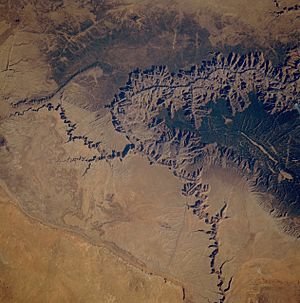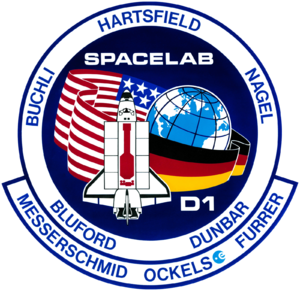STS-61-A facts for kids

Guion S. Bluford, Reinhard Furrer, and Ernst Messerschmid in Spacelab Module LM2, serving as the Spacelab D1 laboratory.
|
|
| Names | Space Transportation System-22 Spacelab D-1 |
|---|---|
| Mission type | Microgravity research |
| Operator | NASA / ESA (West Germany) |
| Mission duration | 7 days, 0 hour, 44 minutes, 51 seconds (achieved) |
| Distance travelled | 4,682,148 km (2,909,352 mi) |
| Orbits completed | 112 |
| Spacecraft properties | |
| Spacecraft | Space Shuttle Challenger |
| Launch mass | 110,568 kg (243,761 lb) |
| Landing mass | 97,144 kg (214,166 lb) |
| Payload mass | 14,451 kg (31,859 lb) |
| Crew | |
| Crew size | 8 |
| Members |
|
| Start of mission | |
| Launch date | October 30, 1985, 17:00:00 UTC |
| Rocket | Space Shuttle Challenger |
| Launch site | Kennedy Space Center, LC-39A |
| Contractor | Rockwell International |
| End of mission | |
| Landing date | November 6, 1985, 17:44:51 UTC |
| Landing site | Edwards Air Force Base, Runway 17 |
| Orbital parameters | |
| Reference system | Geocentric orbit |
| Regime | Low Earth orbit |
| Perigee | 319 km (198 mi) |
| Apogee | 331 km (206 mi) |
| Inclination | 57.00° |
| Period | 91.00 minutes |
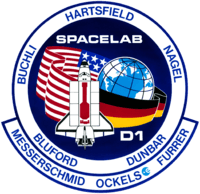 STS-61-A mission patch 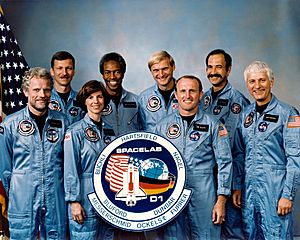 Back: Steven R. Nagel, Guion S. Bluford, Ernst Messerschmid, Wubbo J. Ockels Front: Reinhard Furrer, Bonnie J. Dunbar, James F. Buchli, Henry W. Hartsfield Jr. |
|
STS-61-A was an important space mission, also known as Spacelab D-1. It was the 22nd flight in NASA's Space Shuttle program. This mission was special because it was mostly paid for and managed by West Germany. That's why it had the name D-1, which stands for "Deutschland-1" (Germany-1).
STS-61-A was the ninth and last successful flight of the Space Shuttle Challenger. It holds a world record for having the largest crew ever on a single spacecraft. Eight people flew together from launch to landing!
The mission carried a special laboratory module called Spacelab into orbit. This lab, built by NASA and the European Space Agency (ESA), held 76 scientific experiments. The mission was a big success. Instead of NASA's usual control center, the experiments were managed from the German Space Operations Center in West Germany. This was also the first time a spaceflight had many crew members from a country other than the United States or the Soviet Union.
Contents
Meet the Crew
The STS-61-A mission had a record-breaking crew of eight astronauts. They worked together to complete all the scientific tasks in space.
| Position | Astronaut | |
|---|---|---|
| Commander | Third flight spaceflight |
|
| Pilot | Second flight spaceflight |
|
| Mission Specialist 1 | First flight spaceflight |
|
| Mission Specialist 2 | Second flight spaceflight |
|
| Mission Specialist 3 | Second flight spaceflight |
|
| Payload Specialist 1 | Only flight spaceflight |
|
| Payload Specialist 2 | Only flight spaceflight |
|
| Payload Specialist 3 | Only flight spaceflight |
|
Mission Highlights
The Space Shuttle Challenger launched from Launch Complex 39A in Florida. This happened on October 30, 1985, at 12:00 p.m. EST. It was the first time a Space Shuttle mission was mostly funded and run by another country, West Germany. It was also the only Shuttle flight to ever launch with eight crew members.
The main goal of STS-61-A was to do many experiments in a special lab called Spacelab D-1. These experiments focused on how things behave in microgravity. Microgravity is a state where gravity's effects are very small, making things feel weightless.
Scientific Experiments
The Spacelab D-1 module carried 76 experiments. These included studies on how liquids move (fluid physics), how materials solidify, and how crystals grow. Scientists also studied how plants and cells work in space. Medical experiments looked at how the human body adapts to being in space.
One interesting piece of equipment was the Vestibular Sled. This sled allowed a test subject to be moved back and forth with precise movements. Scientists used it to study how the human body's balance system works in microgravity. This helped them understand how astronauts adapt to space.
Teamwork in Space
NASA was in charge of flying the Space Shuttle safely. West Germany was responsible for all the scientific research. German scientists on the ground worked closely with the astronauts in orbit. They managed the experiments from the German Space Operations Center near Munich.
The astronauts in space were split into two teams. They worked in shifts around the clock to keep the experiments going 24 hours a day. Communication between the ground teams and the astronauts was excellent. This mission showed that having one control center for the spacecraft and another for the experiments could work very well.
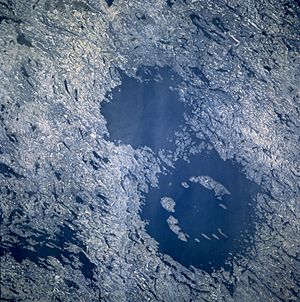
During the mission, a small satellite called GLOMR was successfully released from the cargo bay. Other experiments mounted outside the Spacelab module also collected useful data.
Challenger landed at Edwards Air Force Base on November 6, 1985. The mission lasted 7 days, 0 hours, 44 minutes, and 51 seconds. This was the last successful flight of Space Shuttle Challenger. Sadly, Challenger was destroyed during its next launch, STS-51-L, in January 1986.
Mission Records
STS-61-A set a record for having the most people in space on a single spacecraft. Its crew of eight was the largest ever. Before this, the most people on a Shuttle mission was seven, on STS-41-G in October 1984.
This mission also marked a special moment for the Dutch. While other European astronauts had flown before, Wubbo J. Ockels became the first Dutch citizen to go into space.
Guion S. Bluford was already famous as the first African-American in space from his flight on STS-8. With STS-61-A, he became the first African-American to fly in space twice. He later flew two more times, on STS-39 in 1991 and STS-53 in 1992.
Mission Patch
The mission patch for STS-61-A was chosen by the eight crew members. It shows the Space Shuttle Challenger carrying the long Spacelab science module. The patch highlights the international crew from Europe and the United States. Since Germany played a big part, the German flag and "D-1" are clearly shown. The patch also includes the ESA logo next to Wubbo Ockels' name, celebrating him as the first Dutch person in space.
Images for kids
See also
 In Spanish: STS-61-A para niños
In Spanish: STS-61-A para niños


